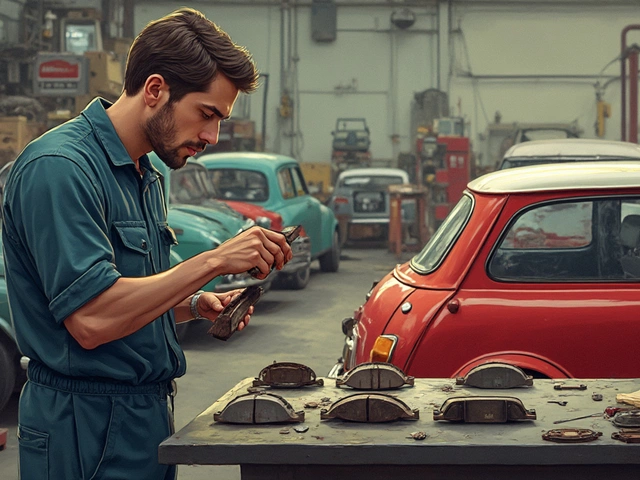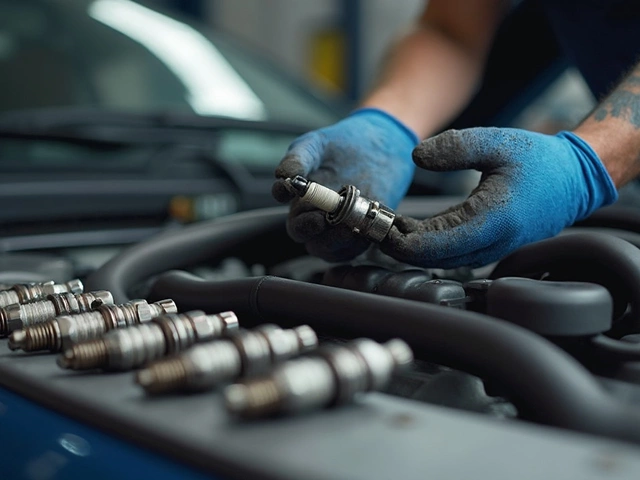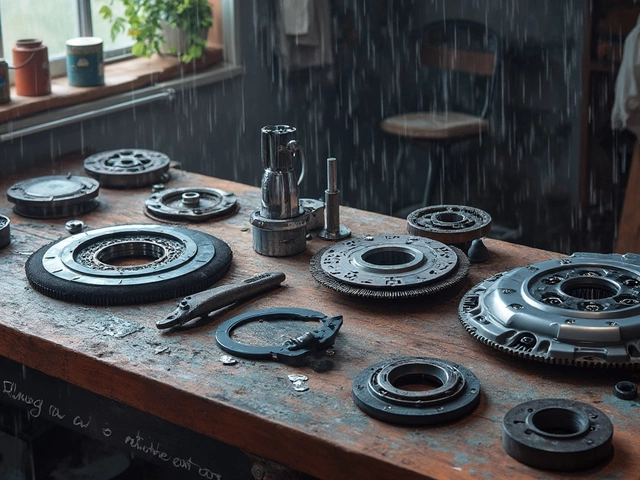Ever felt like your car is auditioning for a trampoline competition whenever you hit a bump? That's a sign your suspension might need some love. It's not just about comfort—proper suspension is crucial for your vehicle's performance and safety. How do you know when it's time for a change?
A good starting point is listening to your car. If you hear clunking noises or feel unusual vibrations while driving, these could be red flags. And don't forget to check your mileage; even high-mileage warriors need a suspension check-up every now and then. If those rides over speed bumps are turning into free rollercoaster rides, it might be time for some maintenance.
- Recognizing the Signs
- Potential Risks of Ignoring Issues
- DIY Suspension Tests
- When to Consult a Professional
- Tips for Suspension Maintenance
Recognizing the Signs
Knowing when your car's suspension is on its last legs can save you from expensive repairs down the line. But what signs should you look out for? Let’s break it down.
Shaky, Shaky Ride
One of the most obvious signs is a bouncy, uncomfortable ride. Imagine driving over a speed bump and your car just keeps bobbing away. If this sounds familiar, it might be time to inspect your suspension parts.
Uneven Tire Treads
Take a look at your tires. Are they wearing out unevenly? This could mean your suspension isn’t holding the tires even on the road. Not only does this lead to costly tire replacements, it’s also an indicator that your suspension might be out of whack.
Drifting and Pulling
Feel your car pulling to one side even when you’re driving straight? That might be a sign of suspension issues. While it could be an alignment problem, a regularly drifting car might need its suspension checked out.
Nose Diving Stopping
If your car's front dips forward upon braking sharply, it’s a classic symptom of worn-out suspension. This 'nose dive' not only feels weird but also increases stopping distances, affecting safety.
Clunky Noises
No one likes mysterious clunking noises when driving. If your car makes weird sounds over bumps or potholes, your suspension parts could be loose or damaged.
Keeping an eye and ear out for these signs of bad suspension can help you catch problems early. If in doubt, a quick check by a mechanic can confirm whether it's time for some maintenance.
Potential Risks of Ignoring Issues
Overlooking the need for a suspension replacement isn't just about enduring a rough ride. Trouble lurking in your suspension system can snowball into serious safety risks and costly damage if left unchecked. So, what's at stake here?
Degrading Vehicle Control
An inefficient suspension can severely affect how your car handles. Without properly functioning shocks or struts, your vehicle struggles for control, especially around tight corners. This isn’t just about comfort; it can dramatically compromise your safety on the road.
Increased Stopping Distances
If a worn-out suspension is left unattended, stopping distances can increase. The car's ability to grip the road effectively is diminished, which is especially dangerous in emergency stops. You definitely don't want to drive with brakes and suspension that play against each other.
Uneven Tire Wear
Your tires might be telling a story of negligence. A suspension that’s out of whack can result in uneven tire wear, which leads to reduced lifespan for your tires and may even result in expensive replacements. Notice cycling through new tires more often than your favorite playlist? Check your suspension!
Road Bumps Cause Structural Damage
Ignoring suspension issues can cause bumps and impacts to travel through the vehicle's frame and components. Over time, this can lead to detrimental structural damage that impacts both vehicle integrity and resale value.
| Issue | Consequence |
|---|---|
| Worn-Out Shocks | Poor Vehicle Control |
| Suspension Misalignment | Uneven Tire Wear |
| Ignored Suspension Replacement | Decreased Safety |
In a nutshell, ignoring suspension problems is like playing a game of chicken with your car's performance and safety. Not to mention the financial hit you'll take when repairs stack up. So keep an ear to the ground and address those limitations before they get worse.

DIY Suspension Tests
Checking your suspension at home isn't just for gearheads. You can do a couple of simple tests to see if you've got potential issues on your hands. It's all about knowing what to look for and having a bit of patience.
Bounce Test
First off, try the classic bounce test. With the car parked, push down hard on the front end and let go. Watch how many times it bounces. Ideally, your car should bounce back up and settle right away. If it keeps bouncing, there could be a problem with the struts or shocks, which is a major suspension replacement signal.
Visual Inspection
Pop the hood and take a good look at the shocks and struts. Check for oil leaks, which might indicate a failing shock absorber. Also, see if your car is sitting level. A sagging corner means you might need to sort out the springs or other suspension parts.
Listen for Noises
Take the car for a short drive on a bumpy road. Listen for knocking or squeaking sounds—these are common symptoms of bad suspension components like loose joints or damaged bushings.
Steering Feel
Notice how the vehicle handles while steering. If it feels loose or you have to fight the wheel to keep straight, these could be signs of suspension wear affecting the handling.
Uneven Tire Wear
Keep an eye on your tires for odd wear patterns. Uneven wear might mean your suspension is messing with wheel alignment, a sure sign it's time for a check.
Keeping Track
It's a good idea to jot down what you find in a simple table like this. It'll help when you talk to a mechanic later:
| Test | Observation |
|---|---|
| Bounce Test | [Note the number of bounces] |
| Visual Inspection | [Note any leaks or sagging] |
| Noise Check | [Note any noises heard] |
| Steering Feel | [Note any handling issues] |
| Tire Wear | [Note uneven patterns] |
Doing these tests can give you a heads-up on any potential issues before they become a big deal. Remember, catching a problem early can save you a ton of money and hassle.
When to Consult a Professional
You might be a hands-on kind of person, but sometimes, knowing when to call in the experts can save you a ton of headache—and money. We're talking about the moments when your car's suspension replacement needs a trained eye. Here’s when you should think about letting a pro take the wheel.
Complex Suspension Issues
Not every problem is DIY-friendly. If your ride starts pulling to one side or the steering feels wonky, it could mean deeper suspension issues, like alignment problems. A professional can diagnose and fix the problem effectively, ensuring you’re not causing further harm while trying to save a buck.
Lack of Proper Tools
Let’s face it, not everyone has a garage full of advanced tools. Some suspension repairs require specific equipment that most DIYers just don’t have. Pro mechanics have access to these tools—and they know how to use them, sparking another reason to consider visiting your trusted garage.
Time Constraints
Life’s busy! Between work, family, and binge-watching your favorite shows, who has the time? Suspension work can be time-consuming, especially if you're learning as you go. Experts have done it a thousand times before and can likely get it done quicker and right the first time.
Understanding Safety Risks
Mucking about with your car’s suspension isn’t just about comfort. Messing it up can become a safety hazard. Professionals not only ensure the job gets done but also test the vehicle to confirm it meets safety standards. Peace of mind is worth the service charge!
So, if that thought bubble of attempting a DIY job on a serious suspension issue feels daunting, it's smart—a trained mechanic will spot things you didn't even know could go wrong. Plus, knowing when to consult with a professional ensures your vehicle maintenance is in top condition. It's all about making sure you and everyone in your car stays safe on the road!

Tips for Suspension Maintenance
Taking good care of your car’s suspension is like giving it a spa day—it simply feels better on the road. And who doesn't love a smooth ride? Let’s dig into some easy ways to keep your car suspension in top shape.
Regular Inspections
Getting under the car may not be your favorite weekend plan, but regularly checking the suspension parts for wear and tear can save you from future headaches. Look for issues like cracked bushings, worn-out shocks, or leaky struts. Catching problems early is key!
Keep an Eye on Tires
Uneven or rapid tire wear is a telltale sign that something’s off with your suspension. Rotate your tires regularly and maintain proper tire pressure. Strong tires are a vital part of the vehicle maintenance equation.
Lubrication is Key
Your car's suspension involves lots of moving parts. Just like a well-oiled machine functions better, ensuring all components are properly lubricated makes a big difference. It keeps everything working smoothly and prevents rust.
Clean After Off-Road Rides
If your adventures often take you off the beaten path, make it a habit to clean your suspension system. Mud and debris can accumulate and damage suspension replacement parts over time. A simple rinse post-ride could extend the life of your setup.
| Maintenance Task | Recommended Frequency |
|---|---|
| Inspect Suspension | Every 12,000 miles |
| Tire Rotation | Every 6,000-8,000 miles |
| Check Tire Pressure | Monthly |
Know When to Call the Pros
You’ve done your checks, but some things are better left to the experts. If you’re uncertain or see warning signs, consult a professional mechanic. It’s the peace of mind you need to keep hitting the open road with confidence!






